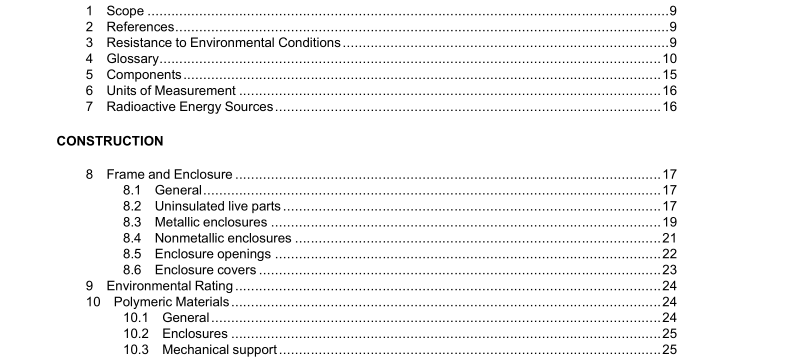UL 924-2020 pdf download.Emergency Lighting and Power Equipment.
4 Glossary 4.1 For the purpose of this standard the following definitions apply. 4.2 AUTOMATIC BATTERY CHARGING EQUIPMENT – Equipment provided to maintain the central storage battery bank in a charged condition at all times when the normal supply is available. 4.3 AUTOMATIC LOAD CONTROL RELAY – An Emergency Lighting Control Device (ELCD) intended to energize, to appropriate power or illumination levels, switched or normally off emergency equipment from an emergency supply in the event of failure of the normal supply, and to de-energize or return the equipment to normal status when the normal supply is restored. These devices are not transfer switches, but instead transmit power only from a single upstream source (typically, the emergency source) to specific loads. They connect to a second (typically, the normal) source of power only for monitoring purposes. 4.4 AUXILIARY LIGHTING AND POWER EQUIPMENT – Equipment associated with or related to, but not interconnected with or required as part of a facility’s emergency lighting or power system. This equipment is not evaluated for compliance with the minimum output (power or light) requirements of the National Electrical Code, ANSI/NFPA 70, the Life Safety Code, NFPA 101, or the International Building Code, and is so marked. 4.5 BATTERY BANK – An enclosed group of batteries intended to supply power to remote lighting or power equipment. 4.6 CENTRAL STATION BATTERY LIGHTING AND POWER SYSTEMS – Systems intended to supply power for emergency lighting equipment, typically consisting of a central storage battery bank, automatic battery charging equipment, inverters, automatic control relays, multi-circuit distribution equipment, derangement alarm equipment, and other applicable accessories. Such equipment may be integrally housed in a single overall enclosure or may be separately enclosed for remote connection to a central control unit.
4.7 CENTRAL STORAGE BATTERY BANK – Storage batteries arranged and connected so as to provide the required emergency system voltage. 4.8 CLASS 2 CIRCUIT – A circuit supplied by an isolating source that complies with the Standard for Class 2 Power Units, UL 1310 or the Class 2 requirements of either the Standard for Low Voltage Transformers – Part 1: General Requirements, UL 5085-1 and the Standard for Low Voltage Transformers – Part 3: Class 2 and Class 3 Transformers, UL 5085-3, or the Limited Power Source Test of the Standard for Household and Commercial Batteries, UL 2054. 4.9 COMBINATION UNIT – A single piece of equipment that functions as an Exit Light and as Unit Equipment. 4.10 COMBUSTION – The decomposition of materials from solid to vapor state, through the application of heat, typically evidenced by flames, smoldering, charring, or mechanical deformation. 4.11 COMPOSITE SOLID STATE SWITCH-INVERTER – Electronic switching circuitry that permits an inverter to function in the emergency mode using only the battery supply.
4.13.1 DIRECTLY CONTROLLED EMERGENCY LUMINAIRE – A luminaire with ALCR functionality to automatically override any control setting (such as dim or “off”) and restore full (or some other pre-set) illumination level upon loss of normal power. The ALCR functionality can be integral to the luminaire or through a control signal input from a remote ELCD. 4.14 DUTY CYCLE – As applicable to flashing exit fixtures and exit lights, duty cycle refers to the light pulse duration (“on” time) expressed either as a percentage or fraction of the cycle duration or as both the light pulse duration and duration between successive light pulses (“off” time). 4.15 ELECTROLUMINESCENT – The emission of light from a phosphor excited by an electromagnetic field. 4.16 EMERGENCY BALLAST – An assembly with batteries, a charger, high frequency inverter, and ELCD (or ELCF circuit) intended to provide emergency power to one or more fluorescent lamps upon loss of normal power. 4.17 EMERGENCY BATTERY PACK – A term used within this standard to refer to both an emergency ballast and an emergency LED driver. 4.18 EMERGENCY LED DRIVER – An assembly with batteries, a charger, LED driver, and ELCD (or ELCF circuit) intended to provide emergency power to one or more LED lamps or arrays upon loss of normal power. 4.18.1 EMERGENCY LIGHTING CONTROL DEVICE (ELCD) – A separate or integral device intended to perform one or more EMERGENCY LIGHTING CONTROL FUNCTIONS. Upon loss of normal power, an ELCD defaults to a position that does not disrupt the flow of emergency power to any controlled emergency load.UL 924-2020 pdf download.
UL 924-2020 pdf download
